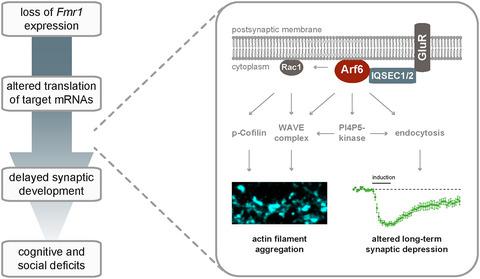当前位置:
X-MOL 学术
›
J. Neurochem.
›
论文详情
Our official English website, www.x-mol.net, welcomes your
feedback! (Note: you will need to create a separate account there.)
The small GTPase Arf6 is dysregulated in a mouse model for fragile X syndrome
Journal of Neurochemistry ( IF 4.2 ) Pub Date : 2020-10-30 , DOI: 10.1111/jnc.15230 Dušica Briševac 1, 2 , Ralf Scholz 3 , Dan Du 4 , Mohammad Nael Elagabani 1 , Georg Köhr 4, 5 , Hans-Christian Kornau 1, 3, 6
Journal of Neurochemistry ( IF 4.2 ) Pub Date : 2020-10-30 , DOI: 10.1111/jnc.15230 Dušica Briševac 1, 2 , Ralf Scholz 3 , Dan Du 4 , Mohammad Nael Elagabani 1 , Georg Köhr 4, 5 , Hans-Christian Kornau 1, 3, 6
Affiliation

|
Fragile X syndrome (FXS), the most common inherited cause of intellectual disability, results from silencing of the fragile X mental retardation gene 1 (FMR1). The analyses of FXS patients’ brain autopsies revealed an increased density of immature dendritic spines in cortical areas. We hypothesize that the small GTPase Arf6, an actin regulator critical for the development of glutamatergic synapses and dendritic spines, is implicated in FXS. Here, we determined the fraction of active, GTP‐bound Arf6 in cortical neuron cultures and synaptoneurosomes from Fmr1 knockout mice, measured actin polymerization in neurons expressing Arf6 mutants with variant GTP‐ or GDP‐binding properties, and recorded hippocampal long‐term depression induced by metabotropic glutamate receptors (mGluR‐LTD) in acute brain slices. We detected a persistently elevated Arf6 activity, a loss of Arf6 sensitivity to synaptic stimulation and an increased Arf6‐dependent dendritic actin polymerization in mature Fmr1 knockout neurons. Similar imbalances in Arf6‐GTP levels and actin filament assembly were caused in wild‐type neurons by RNAi‐mediated depletion of the postsynaptic Arf6 guanylate exchange factors IQSEC1 (BRAG2) or IQSEC2 (BRAG1). Targeted deletion of Iqsec1 in hippocampal neurons of 3‐week‐old mice interfered with mGluR‐LTD in wild‐type, but not in Fmr1 knockout mice. Collectively, these data suggest an aberrant Arf6 regulation in Fmr1 knockout neurons with consequences for the actin cytoskeleton, spine morphology, and synaptic plasticity. Moreover, FXS and syndromes caused by genetic variants in IQSEC1 and IQSEC2 share intellectual disabilities and developmental delay as main symptoms. Therefore, dysregulation of Arf6 may contribute to the cognitive impairment in FXS.
中文翻译:

小GTPase Arf6在脆性X综合征的小鼠模型中失调
脆性X综合征(FXS)是智力残疾最常见的遗传原因,其原因是脆性X智力低下基因1(FMR1)沉默。FXS患者的脑部尸检分析表明,皮质区域的未成熟树突棘密度增加。我们假设,小的GTPase Arf6(一种对谷氨酸能突触和树突棘的发育至关重要的肌动蛋白调节剂)与FXS有关。在这里,我们确定了Fmr1的皮质神经元培养物和突触小体中活跃的,与GTP结合的Arf6的比例。敲除小鼠,测量表达具有GTP或GDP结合特性的Arf6突变体的神经元中的肌动蛋白聚合,并记录由代谢型谷氨酸受体(mGluR-LTD)在急性脑切片中诱导的海马长期抑制。我们检测到在成熟的Fmr1基因敲除神经元中Arf6活性持续升高,对突触刺激的Arf6敏感性丧失以及依赖于Arf6的树突状肌动蛋白聚合增加。RNAi介导的突触后Arf6鸟苷酸交换因子IQSEC1(BRAG2)或IQSEC2(BRAG1)的RNAi耗竭在野生型神经元中引起了类似的Arf6-GTP水平和肌动蛋白丝装配失衡。3周龄小鼠海马神经元中Iqsec1的靶向缺失在野生型中会干扰mGluR-LTD,而在野生型中则不会Fmr1基因敲除小鼠。总体而言,这些数据表明Fmr1基因敲除神经元中异常的Arf6调节,对肌动蛋白的细胞骨架,脊柱形态和突触可塑性具有影响。此外,由IQSEC1和IQSEC2的遗传变异引起的FXS和综合症以智力障碍和发育迟缓为主要症状。因此,Arf6的失调可能导致FXS的认知障碍。
更新日期:2020-10-30
中文翻译:

小GTPase Arf6在脆性X综合征的小鼠模型中失调
脆性X综合征(FXS)是智力残疾最常见的遗传原因,其原因是脆性X智力低下基因1(FMR1)沉默。FXS患者的脑部尸检分析表明,皮质区域的未成熟树突棘密度增加。我们假设,小的GTPase Arf6(一种对谷氨酸能突触和树突棘的发育至关重要的肌动蛋白调节剂)与FXS有关。在这里,我们确定了Fmr1的皮质神经元培养物和突触小体中活跃的,与GTP结合的Arf6的比例。敲除小鼠,测量表达具有GTP或GDP结合特性的Arf6突变体的神经元中的肌动蛋白聚合,并记录由代谢型谷氨酸受体(mGluR-LTD)在急性脑切片中诱导的海马长期抑制。我们检测到在成熟的Fmr1基因敲除神经元中Arf6活性持续升高,对突触刺激的Arf6敏感性丧失以及依赖于Arf6的树突状肌动蛋白聚合增加。RNAi介导的突触后Arf6鸟苷酸交换因子IQSEC1(BRAG2)或IQSEC2(BRAG1)的RNAi耗竭在野生型神经元中引起了类似的Arf6-GTP水平和肌动蛋白丝装配失衡。3周龄小鼠海马神经元中Iqsec1的靶向缺失在野生型中会干扰mGluR-LTD,而在野生型中则不会Fmr1基因敲除小鼠。总体而言,这些数据表明Fmr1基因敲除神经元中异常的Arf6调节,对肌动蛋白的细胞骨架,脊柱形态和突触可塑性具有影响。此外,由IQSEC1和IQSEC2的遗传变异引起的FXS和综合症以智力障碍和发育迟缓为主要症状。因此,Arf6的失调可能导致FXS的认知障碍。











































 京公网安备 11010802027423号
京公网安备 11010802027423号